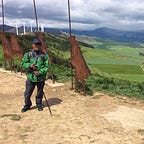Magic, Dream and Fantasy Permeate The New York Botanical Garden’s Yearly Train Show and Glow
A passage to New York’s iconic landmarks through immersive botanic architecture
The New York Botanical Garden’s (NYBG) Holiday Train Show is now into its 31st anniversary. Beginning with a small-scale event in 1992 with just four trains and 15 replicas of New York landmarks, the show has expanded into a massive annual event dazzling and enchanting visitors of all ages to a make-belief world set in one of the most iconic gardens in the world. The show’s main venue is the Enid A. Haupt Conservatory, the iconic Victorian glasshouse, that features nearly 200 of the city’s landmarks with 25 G-scale trains and trolleys meandering past or above them along a half-mile track.
In harmony with their botanic surroundings, the city’s landmarks are all created from natural plant materials created from tree branches, twigs, leaves, seeds, twigs, barks, acorns, cinnamon sticks, and reeds. The concept of botanical architecture was originally developed by Applied Imagination’s founding visionary, Paul G. Busse. Established in 1991, Applied Imagination was the result of Busse’s work with landscaping, garden railroads, and his use of plant material. Since 1992, Busse and his team have been meticulously handcrafting the miniature landmarks for the show. Based in Northern Kentucky, they harvest much of their materials from the forest surrounding them.
In recent times the main show has now acquired a special dimension with the addition of NYBG Glow, the display of the garden’s sights, grounds, and buildings with incandecent lights and sounds. Among others, both the Haupt Conservatory and the LuEsther T. Mertz Library Building transform into glittering canvases. NYBG Glow adds a magical dimension to the Train Show accentuating the holiday spirit.
Here are several highlights from my recent visit to this year’s show:
A constellation of Midtown and Lower Manhattan’s most famous landmarks frame the show
The show is a tribute to the intricate network of trains and bridges linking the city far and wide
The show is a time travel to the city’s past landmarks that once towered its landscape
The creative, cultural and entertainment dimensions of the city come alive in miniature landmarks
The show is a tribute to both well-known and lesser-known structures
The show celebrates two of NYBG’s crown jewels
NYBG Glow
Into its fourth year, the NYBG Glow provides a fitting complement to the Train Show with an enchanting and whimsical decoration of lights throughout the grounds. The pathways, the Haupt Conservatory and the Mertz Library Building are lit up with colors with thousands of energy-efficient LED lights and festive installations. A leisurely stroll through the Garden’s 1.5-mile colorful pathway has the feel of a dreamy walk-through fantasy island. It’s all an ideal setting for a lasting family holiday memory.
NYBG’s Yearly Train Show and Glow for the current season will come to end on January 13. It will return later this year for its 32nd season.
